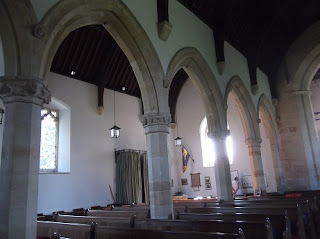On arrival in Reading I made the short walk to Friar's Walk where the Ibis was situated. I managed to walk right past the very discrete entrance as the sign was obscured by one of the huge hanging baskets of flowers found all over the entre of Reading.
The central part of Reading is both compact and full of old buildings, such as the George Hotel, where I ate dinner.
At one end of the town centre is the chuch of St Lawrence which plays a part in the history of segments o my family
while St Mary is situated on the other side and also manages to get a look in from the family history perspective.
Here are some other examples of buildings in the central part of Reading:
The central part of the town seems well used and was buzzing with life well into the evening. Along a canal on the southern side of the town centre there are heaps of eateries which were busy every night I was there.
My first day at the Berkshire Records Office (BRO) yielded very little. I was no further advance in seeking information about the Glaville clan than when i left home.
Tuesday was my day to go to Windsor Castle. isn't that an enormous place. It covers a huge area within the walls without even mentioning the park.
The castle dominates the town and the town seems to live on the visitors coming to the castle.
As well as being able to walk around the grounds within the wall it was possible to visit the chapel, the state rooms and an exhibition of the royal families toys. The chapel is the burial place of a number of the monachs and their spouses. I gave the toys a miss but did go through the state rooms. Just maintaining them in their splendor must cost a fortune for which the visitors to the castle contribute greatly.
 |
| The changing of the guard |
 |
| Windsor Great Park |
On returning to Reading I walk around part of the central area that I had not been to on the previous night. This included the Abbey area. Edward VIII has much to answer for in the eventual distruction of so many magnificent buildings.
Wednesday was a continuation of the same frustration at the BRO. I simply could not get a handle on my Glanvilles. Nothing seemed to add up.
At 12:30 I was collected by friends Sally and Robin and we headed north in search of a farm that was was in the hands of the Brangwins for about 100 years.
The first place we stopped for lunch was one that Sally and Robin had been to a number of times before. It sat on the edge of the River Thames. Unfortunately it was very busy and had a long wait for food so we gave them a miss and found another place. We stopped there for a drink on our way back to Reading.
Our target was in the Bartons - a series of villages named variously named Westcott Barton, Middle Barton and Steeple Barton. The farm was:
We walked through the farmyard and up onto a highpoint where we had a great view across the copped and brilliant green farmland. It was a public footpath so we were not trespassing.
Oh, we were also told that Whistlow Farm is now part of a much larger farm which covers six previous farms. Does this sound familar?
Off we went along some very narrow lanes and we eventually came to the church. Almost all the old tombstones were stacked up next to the fence with a few being used for paving. Sally and I thought that we did not have much hope of finding anything worthwhile.
we were surprised to find the church unlocked - an increasingly rare situation across England as so many churches have sucumbed to vandalism.
 |
| Baptismal Font at St Mary the Virgin, Steeple Barton |
As we were looking around the church interior Sally spied a stone slab on the floor with Brangwin chiselled in it. In all, there were three stones within the church. A surprising find.
Next came the search for the house that was built by the Brangwins during the 1730s. From local intelligence this appears to be it albeit a little modified over the years.
All up we had a wonderful afternoon out and about in Oxfordshire looking for family stuff.
Thursday saw me back at the BRO and I started crawling through Wills. I came across one relating to my 5xgreat grandfather which solved some of my mysteries but left me scratching my head about others. The Will was very long, the writing beautiful but the ink faded which made reading it hard work.
Giving up for the day shortly after 5pm I went and utilised the laundromat that I had spied earlier in the day.
On Friday morning I was back at the BRO and actually got to read the original of the Will I had looked at on film the previous day. This was the actual document signed by John Granvill way back when. I was fortunate to be able to look at the original as normally this does not happen when the document is available on film.
So, after lots of rustration this has been a worthwhile research visit.
After collecting my luggage from the Ibis it was back to London.























No comments:
Post a Comment